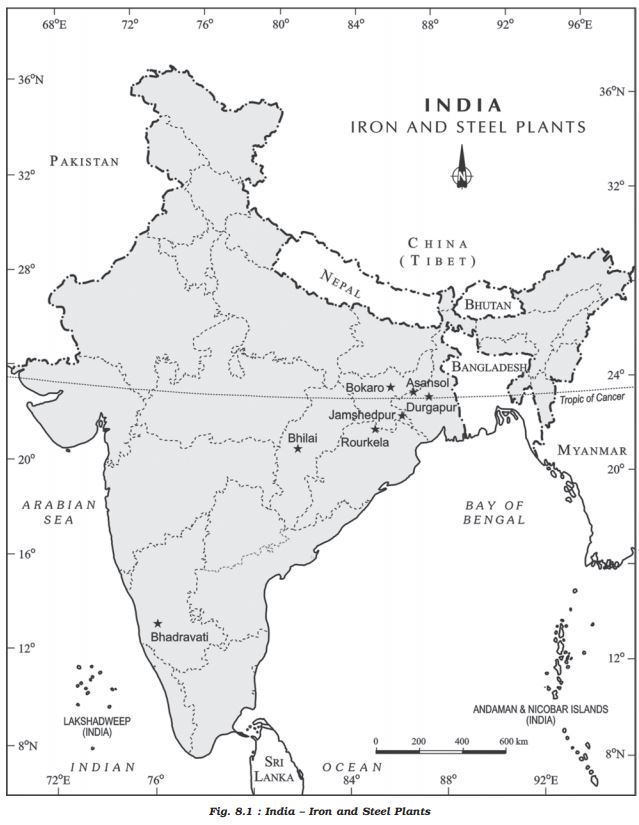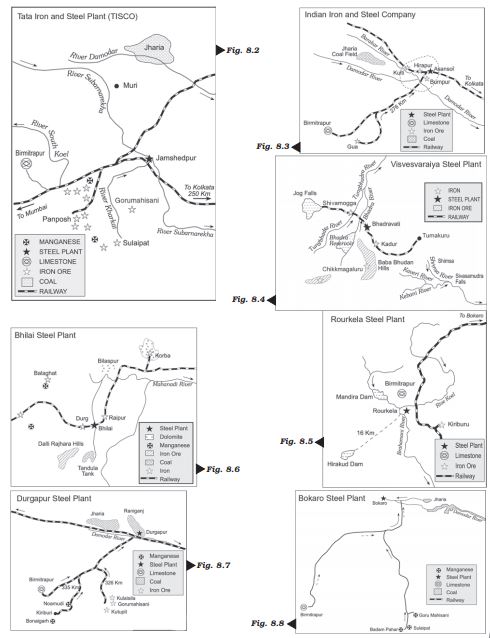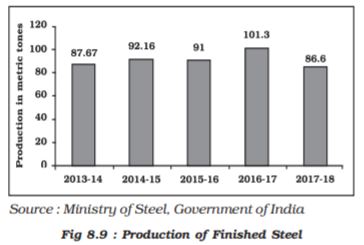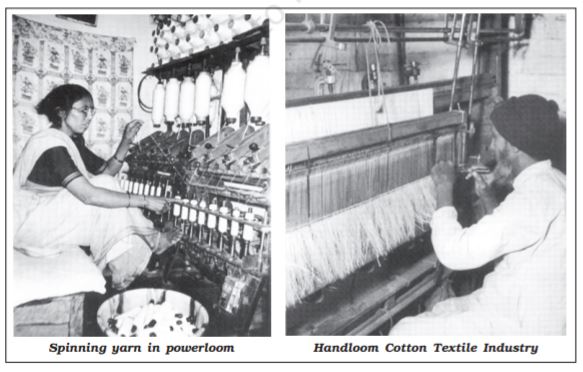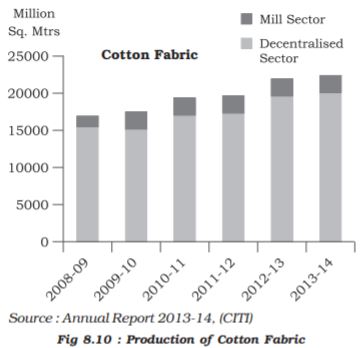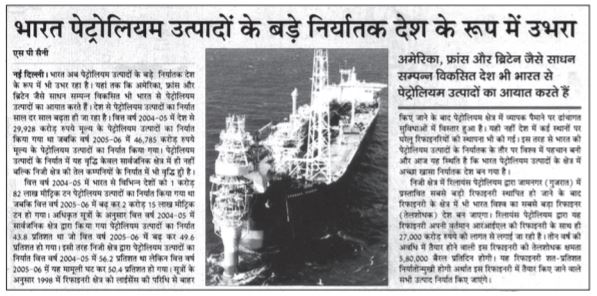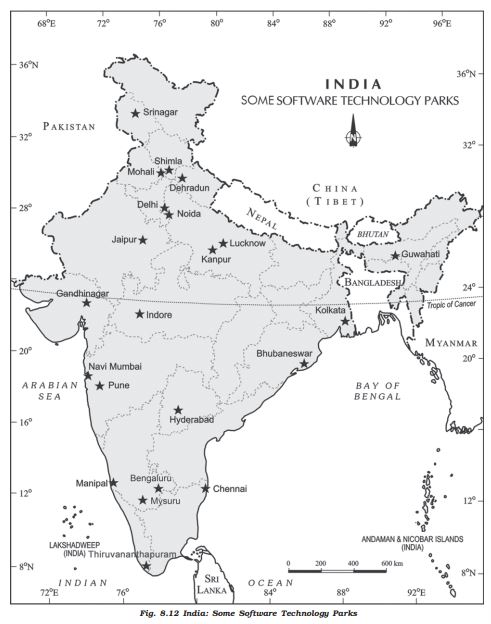Table of Contents

Unit III
Chapter 8
MANUFACTURING INDUSTRIES
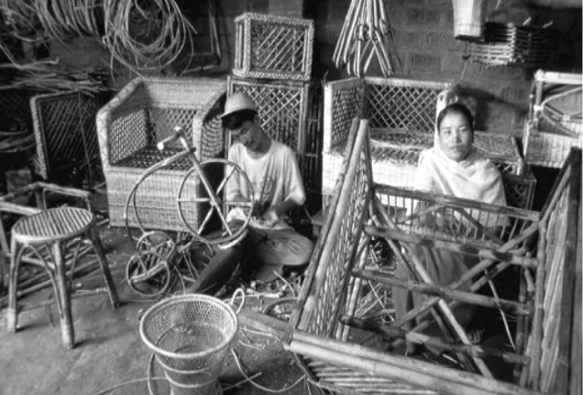
We use various items to satisfy our needs. Agricultural products like wheat, rice, etc. are to be processed into flour, husked rice before we consume these. But besides bread and rice, we also require clothes, books, fans, cars, medicines, etc. and these are manufactured in various industries. In modern times industries have become very important part of an economy. They provide employment to large labour force and contribute significantly in the total national wealth/income.
Types of Industries
Industries are classified in a number of ways. On the basis of size, capital investment and labour force employed, industries are classified as large, medium, small scale, and cottage industries. On the basis of ownership, industries are categorised as :
(i) public sector, (ii) private sector, and (iii) joint and cooperative sector, Public sector enterprises are government/state controlled companies or corporations funded by governments. Industries of strategic and national importance are usually in the public sector. Industries are also classified on the basis of the use of their products such as :
(i) basic goods industries, (ii) capital goods industries (iii) intermediate goods industries, and (iv) consumer goods industries.
Another method of classifying industries is on the basis of raw materials used by them. Accordingly, these can be : (i) agriculture-based industries, (ii) forest-based industries, (iii) mineral-based industries, and
(iv) industrially processed raw material-based industries.
Another common classification of industries is based on the nature of the manufactured products. Eight classes of industries, thus identified are : (1) Metallurgical Industries, (2) Mechanical Engineering Industries, (3) Chemical and Allied Industries, (4) Textile Industries, (5) Food Processing Industries, (6) Electricity Generation,
(7) Electronics and (8) Communication Industries. Sometimes, you also read about foot loose industries. What are these? Have they any relationship with raw material location or not?
Location of Industries
Can you guess the reasons for the location of iron and steel industry in eastern and southern India? Why is there no iron and steel industry in U.P., Haryana, Punjab, Rajasthan and Gujarat?
Location of industries is influenced by several factors like access to raw materials, power, market, capital, transport and labour, etc. Relative significance of these factors varies with time and place. There is strong relationship between raw material and type of industry. It is economical to locate the manufacturing industries at a place where cost of production and delivery cost of manufactured goods to consumers are the least. Transport costs, to a great extent, depend on the nature of raw materials and manufactured products. A brief description of factors influencing the location of industries are given below:
Raw Materials
Industries using weight-losing raw materials are located in the regions where raw materials are located. Why are the sugar mills in India located in sugarcane growing areas? Similarly, the locations of pulp industry, copper smelting and pig iron industries are located near their raw materials. In iron and steel industries, iron ore and coal both are weight-losing raw materials. Therefore, an optimum location for iron and steel industries should be near raw material sources. This is why most of the iron and steel industries are located either near coalfields (Bokaro, Durgapur, etc.) or near sources of iron ore (Bhadravati, Bhilai, and Rourkela). Similarly, industries based on perishable raw materials are also located close to raw material sources.
Power
Power provides the motive force for machines, and therefore, its supply has to be ensured before the location of any industry. However, certain industries, like aluminium and synthetic nitrogen manufacturing industries tend to be located near sources of power because they are power intensive and require huge quantum of electricity.
Market
Markets provide the outlets for manufactured products. Heavy machine, machine tools, heavy chemicals are located near the high demand areas as these are market orientated. Cotton textile industry uses a non-weight-losing raw material and is generally located in large urban centre, e.g. Mumbai, Ahmedabad, Surat, etc. Petroleum refineries are also located near the markets as the transport of crude oil is easier and several products derived from them are used as raw material in other industries. Koyali, Mathura and Barauni refineries are typical examples. Ports also play a crucial role in the location of oil refineries.
Transport
Have you ever tried to find out the reasons for the concentration of industries in Mumbai, Chennai, Delhi and in and around Kolkata? It was due to the fact that they initially became the nodal point having transport links. The industries shifted to interior locations, only when railway lines were laid. All major industrial plants are located on the trunk rail routes.
Labour
Can we think of an industry without labour? Industries require skilled labour. In India, labour is quite mobile and is available in large numbers due to our large population.
Historical Factors
Have you ever thought of the reasons for emerging Mumbai, Kolkata and Chennai as industrial nodes? These locations were greatly influenced by our colonial past. During the initial phase of colonisation, manufacturing activities received new impetus provided by the European traders. Places like Murshidabad, Dhaka, Bhadohi, Surat, Vadodara, Kozhikode, Coimbatore, Mysuru etc., emerged as important manufacturing centres. In the subsequent industrial phase of colonialism, these manufacturing centres experienced rapid growth due to competition from the goods manufactured in Britain and the discriminatory policies of colonial power.
In the last phase of colonialism, the British promoted few industries in selected areas. This led to larger spatial coverage by different types of industries in the country.
Industrial Policy
India, being a democratic country aims at bringing about economic growth with balanced regional development.
Establishment of iron and steel industry in Bhilai and Rourkela were based on decision to develop backward tribal areas of the country. At present, government of India provides lots of incentives to industries locating in backward areas.
Major Industries
The iron and steel industry is basic to the industrial development of any country. The cotton textile Industry is one of our traditional industries. The sugar Industry is based on local raw materials which prospered even in the British period. Besides the more recent petrochemical Industry and the IT industry will be discussed in this chapter.
The Iron and Steel Industry
The development of the iron and steel industry opened the doors to rapid industrial development in India. Almost all sectors of the Indian industry depend heavily on the iron and steel industry for their basic infrastructure. Can we make tools to be used in agriculture without iron?
The other raw materials besides iron ore and coking coal, essential for iron and steel industry are limestone, dolomite, manganese and fire clay. All these raw materials are gross (weight losing), therefore, the best location for the iron and steel plants is near the source of raw materials. In India, there is a crescent shaped region comprising parts of Chhattisgarh, Northern Odisha, Jharkhand and western West Bengal, which is extremely rich in high grade iron ore, good quality coking coal and other supplementing raw materials.
The Indian iron and steel industry consists of large integrated steel plants as well as mini steel mills. It also includes secondary producers, rolling mills and ancillary industries.
Integrated Steel Plants
TISCO
The Tata Iron and Steel plant lies very close to the Mumbai-Kolkata railway line and about 240 km away from Kolkata, which is the nearest port for the export of steel. The rivers Subarnarekha and Kharkai provide water to the plant. The iron ore for the plant is obtained from Noamundi and Badam Pahar and coal is brought from Joda mines in Odisha. Coking coal comes from Jharia and west Bokaro coalfields.
IISCO
The Indian Iron and Steel Company (IISCO) set up its first factory at Hirapur and later on another at Kulti. In 1937, the Steel corporation of Bengal was constituted in association with IISCO and set up another iron and steel producing unit at Burnpur (West Bengal). All the three plants under IISCO are located very close to Damodar valley coal fields (Raniganj, Jharia, and Ramgarh). Iron ore comes from Singhbhum in Jharkhand. Water is obtained from the Barakar River, a tributary of the Damodar. All the plants are located along the Kolkata-Asansol railway line. Unfortunately, steel production from IISCO fell considerably in 1972-73 and the plants were taken over by the government.
Visvesvaraiya Iron and Steel Works Ltd. (VISL)
The third integrated steel plant, the Visvesvaraiya Iron and Steel Works, initially called the Mysore Iron and Steel Works, is located close to an iron ore producing area of Kemangundi in the Bababudan hills. Limestone and manganese are also locally available. But this region has no coal. At the beginning, charcoal obtained by burning wood from nearby forests was used as fuel till 1951. Afterwards, electric furnaces were installed which use hydroelectricity from the Jog Falls hydel power project. The Bhadravati river supplies water to the plant. This plant produces specialised steels and alloys.
After independence, during the Second Five Year Plan (1956-61), three new integrated steel plants were set up with foreign collaboration: Rourkela in Odisha, Bhilai in Chhattisgarh and Durgapur in West Bengal. These were public sector plants under Hindustan Steel Limited (HSL). In 1973, the Steel Authority of India Limited (SAIL) was created to manage these plants.
Rourkela Steel Plant
The Rourkela Steel plant was set up in 1959 in the Sundargarh district of Odisha in collaboration with Germany. The plant was located on the basis of proximity to raw materials, thus, minimising the cost of transporting weight losing raw material. This plant has a unique locational advantage, as it receives coal from Jharia (Jharkhand) and iron ore from Sundargarh and Kendujhar. The Hirakud project supplies power for the electric furnaces and water is obtained from the Koel and Sankh rivers.
Bhilai Steel Plant
The Bhilai Steel Plant was established with Russian collaboration in Durg district of Chhattisgarh and started production in 1959. Iron ore comes from Dalli-Rajhara mine (Fig. 8.6) and coal from Korba and Kargali coal fields. Water comes from the Tanduladam and the power from the Korba Themal Power Station. This plant also lies on the Kolkata-Mumbai railway route. The bulk of the steel produced goes to the Hindustan Shipyard at Vishakhapatnam.
Durgapur Steel Plant
Durgapur Steel Plant in West Bengal was set up in collaboration with the government of the United Kingdom and started production in 1962. This plant lies in Raniganj and Jharia coal belt and gets iron ore from Noamundi (Fig. 8.7). Durgapur lies on the main Kolkata-Delhi railway route. Hydel power and water is obtained from the Damodar Valley Corporation (DVC).
Bokaro Steel Plant
This steel plant was set up in 1964 at Bokaro with Russian collaboration. This plant was set up on the principle of transportation cost minimisation by creating Bokaro-Rourkela combine. It receives iron ore from the Rourkela region and the wagons on return take coal to Rourkela. Other raw materials come to Bokaro from within a radius of about 350 km. Water and hydel power is supplied by the Damodar Valley Corporation.
Other Steel Plants
New steel plants which were set up in the Fourth Plan period are away from the main raw material sources. All three plants are located in South India. The Vizag Steel Plant, in Vishakhapatnam in Andhra Pradesh is the first port-based plant which started operating in 1992. Its port location is of advantage.
The Vijaynagar Steel Plant at Hosapete in Karnataka was developed using indigenous technology. This uses local iron ore and limestone. The Salem Steel Plant in Tamil Nadu was commissioned in 1982.
Apart from these major steel plants, there are more than 206 units located in different parts of the country. Most of these use scrap iron as their main raw material, and process it in electric furnaces.
The Cotton Textile Industry
The cotton textile industry is one of the traditional industries of India. In the ancient and the medieval times, it used to be only a cottage industry. India was famous worldwide for the production of muslin, a very fine variety of cotton cloth, calicos, chintz and other different varieties of fine cotton cloth. The development of this industry in India was due to several factors. One, it is a tropical country and cotton is the most comfortable fabric for a hot and humid climate. Second, large quantity of cotton was grown in India. Abundant skilled labour required for this industry was available in this country. In fact, in some areas the people were producing cotton textiles for generations and transferred the skill from one generation to the other and in the process perfected their skills.
Initially, the British did not encourage the development of the indigenous cotton textile industry. They exported raw cotton to their mills in Manchester and Liverpool and brought back the finished products to be sold in India. This cloth was cheaper because it was produced at mass scale in factories in U.K. as compared to the cottage based industries of India.
In 1854, the first modern cotton mill was established in Mumbai. This city had several advantages as a cotton textile manufacturing centre. It was very close to the cotton producing areas of Gujarat and Maharashtra. Raw cotton used to be brought to Mumbai port to be transported to England. Therefore, cotton was available in Mumbai city itself. Moreover, Mumbai even then was the financial centre and the capital needed to start an industry was available there. As a large town, providing employment opportunities attracted labour in large numbers. Hence, cheap and abundant labour too was available locally. The machinery required for a cotton textile mill could be directly imported from England. Subsequently, two more mills, the Shahpur Mill and the Calico Mill were established in Ahmedabad. By 1947, the number of mills in India went up to 423 but the scenario changed after partition, and this industry suffered a major recession. This was due to the fact that the most of the good quality cotton growing areas had gone to West Pakistan and India was left with 409 mills and only 29 per cent of the cotton producing area.
After Independence, this industry gradually recovered and eventually flourished.
The cotton textile industry in India can be broadly divided into two sectors, the organised sector and the unorganised sector. The decentralised sector includes cloth produced in handlooms (including Khadi) and powerlooms. The production of the organised sector has drastically fallen from 81 per cent in the mid-twentieth century to only about 6 per cent in 2000. At present, the powerlooms on the decentralised sector produce more than the handloom sector.
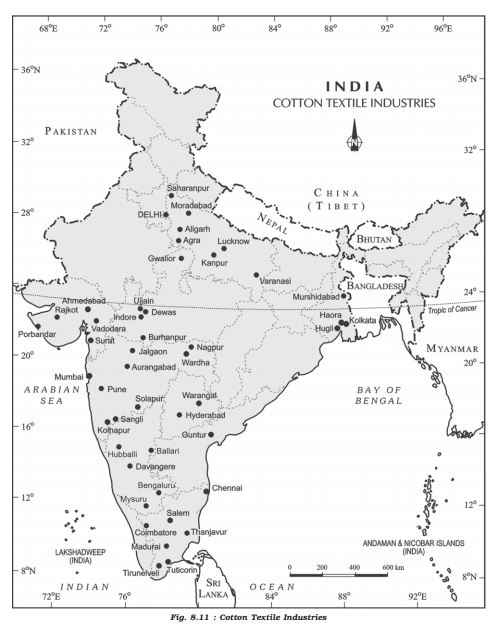
Handloom Cotton Textile Industry
Cotton is a “pure” raw material which does not lose weight in the manufacturing process. so other factors, like, power to drive the looms, labour, capital or market may determine the location of the industry. At present the trend is to locate the industry at or close to markets, as it is the market that decides what kind of cloth is to be produced. Also the market for the finished products is extremely variable, therefore, it becomes important to locate the mills close to the market.
Cotton Fabric
After the first mills were set up in Mumbai and Ahmedabad in the second half of the nineteenth century, the cotton textile industry expanded very rapidly. The number of units increased dramatically. The Swadeshi movement gave a major impetus to the industry as there was a call for boycotting all British made goods in favour of Indian goods. After 1921, with the development of the railway network other cotton textile centres expanded rapidly. In southern India, mills were set up at Coimbatore, Madurai and Bengaluru. In central India, Nagpur, Indore, Solapur and Vadodara became cotton textile centres. Cotton textile mills were set up at Kanpur based on local investment. Mills were also set up at Kolkata due to its port facilities. The development of hydro-electricity also favoured the location of the cotton textile mills away from the cotton producing areas. The rapid development of this industry in Tamil Nadu is the result of the abundant availability of hydel power for the mills. Lower labour costs at centres like Ujjain, Bharuch, Agra, Hathras, Coimbatore and Tirunelveli also caused industries to be located away from cotton producing areas.
Thus, the cotton textile industry is located in almost every state in India, where one or more of the locational factors have been favourable. The importance of raw materials has given way to market or to a cheaper local labour force or it may be the availability of power.
Presently, the major centres of the cotton textile industry are Ahmedabad, Bhiwandi, Solapur, Kolhapur, Nagpur, Indore and Ujjain. All these centres are the traditional centres and are located close to the cotton producing regions. Maharashtra, Gujarat and Tamil Nadu are the leading cotton producing states. West Bengal, Uttar Pradesh, Karnataka, and Punjab are the other important cotton textile producers. (Fig. 8.11)
Tamil Nadu has the largest number of mills and most of them produce yarn rather than cloth. Coimbatore has emerged as the most important centre with nearly half the mills located there. Chennai, Madurai, Tirunelveli, Tuticorin, Thanjavur, Ramanathapuram and Salem are the other important centres. In Karnataka, the cotton textile industry has developed in the cotton producing areas in the north-eastern part of the state. Davangere, Hubballi, Ballari, Mysuru and Bengaluru are important centres. The cotton textile industry is located in the cotton producing Telengana region, where most of the mills are spinning mills producing yarn. The important centres are Hyderabad, Secunderabad and Warangal in Telangana and Guntur in Andhra Pradesh.
In Uttar Pradesh, Kanpur is the largest centre. Some of the other important centres are Modinagar, Hathras, Saharanpur, Agra and Lucknow. In West Bengal, the cotton mills are located in the Hugli region. Howrah, Serampur, Kolkata and Shyamnagar are the important centres.
Production of cotton cloth increased almost five times since independence. Cotton textile has been facing tough competition from synthetic cloth. What are the other problems of cotton textile industry in India?
Sugar Industry
The sugar industry is the second most important agro-based industry in the country. India is the largest producer of both sugarcane and cane sugar and contributes about 8 per cent of the total sugar production in the world. Besides, khandasari and gur or jaggery are also prepared from sugarcane. This industry provides employment for more than 4 lakh persons directly and a large number of farmers indirectly. Sugar industry is a seasonal industry because of the seasonality of raw materials.
Development of the industry on modern lines dates back to 1903, when a sugar mill was started in Bihar. Subsequently, sugar mills were started in other parts of Bihar and Uttar Pradesh. In 1950-51, 139 factories were in operation. The number of sugar factories rose to 662 in 2010-11.
Location of the Sugar Industry
Sugarcane is a weight-losing crop. The ratio of sugar to sugarcane varies between 9 to 12 per cent depending on its variety. Its sucrose content begins to dry during haulage after it has been harvested from the field. Better recovery of sugar is dependent upon its being crushed within 24 hours of its harvesting. Sugar factories hence, are located within the cane producing regions.
Maharashtra has emerged as a leading sugar producer in the country and produces more than one-third of the total production of the sugar in the country.
Uttar Pradesh is the second largest producer of sugar. The sugar factories are concentrated in two belts – the Ganga-Yamuna doab and the tarai region. The major sugar producing centres in the Ganga -Yamuna doab are Saharanpur, Muzaffarnagar, Meerut, Ghaziabad, Baghpat and Bulandshahr districts; while Kheri Lakhimpur, Basti, Gonda, Gorakhpur, Bahraich are important sugar producing districts in the Tarai region.
In Tamil Nadu, sugar factories are located in Coimbatore, Vellore, Tiruvanamalai, Villupuram and Tiruchchirappalli districts. Belagavi, Ballari, Mandya, Shivamogga, Vijayapura and Chitradurg districts are the major producers in Karnataka. The industry is distributed in the coastal regions i.e. East Godavari, West Godavari, Vishakhapatnam districts of Andhra Pradesh and Nizamabad and Medak districts of Telangana.
The other States which produce sugar are Bihar, Punjab, Haryana, Madhya Pradesh and Gujarat. Saran, Champaran, Muzaffarnagar, Siwan, Darbhanga, and Gaya are the important sugarcane producing districts in Bihar. The relative significance of Punjab has declined, although Gurdaspur, Jalandhar, Sangarur, Patiala and Amritsar are major sugar producers. In Haryana, sugar factories are located in Yamuna Nagar, Rohtak, Hissar and Faridabad districts. Sugar industry is comparatively new in Gujarat. Sugar mills are located in the cane growing tracts of Surat, Junagarh, Rajkot, Amreli, Valsad and Bhavnagar districts.
Petrochemical Industries
This group of industries has been growing very fast in India. A variety of products come under this category of industries. In 1960s, demand for organic chemicals increased so fast that it became difficult to meet this demand. At that time, petroleum refining industry expanded rapidly. Many items are derived from crude petroleum, which provide raw materials for many new industries, these are collectively known as petrochemical industries. This group of industries is divided into four sub-groups: (i) polymers, (ii) synthetic fibres, (iii) elastomers, and (iv) surfactant intermediate. Mumbai is the hub of the petrochemical industries. Cracker units are also located in Auraiya (Uttar Pradesh), Jamnagar, Gandhinagar and Hajira (Gujarat), Nagothane, Ratnagiri (Maharashtra), Haldia (West Bengal) and Vishakhapatnam (Andhra Pradesh).
Three organisations are working in the petrochemical sector under the administrative control of the Department of Chemicals and Petrochemicals. First is the Indian Petrochemical Corporation Limited (IPCL), a public sector undertaking. It is responsible for the manufacture and distribution of the various petrochemicals like polymers, chemicals, fibres and fibre intermediates. Second is the Petrofils Cooperative Limited (PCL), a joint venture of the Government of India and Weaver’s Cooperative Societies. It produces polyester filament yarn and nylon chips at its two plants located at Vadodara and Naldhari in Gujarat. Third is the Central Institute of Plastic Engineering and Technology (CIPET), involved in imparting training in petro-chemical industry.
Polymers are made from ethylene and propylene. These materials are obtained in the process of refining crude oil. Polymers are used as raw materials in the plastic industry. Among polymers, polyethylene is a widely used thermoplastic. Plastic is first converted into sheets, powder, resin and pellets, and then used in manufacturing plastic products. Plastic products are preferred because of their strength, flexibility, water and chemical resistance and low prices. Production of plastic polymers started in India in the late fifties and the early sixties using other organic chemicals. The National Organic Chemicals Industries Limited (NOCIL), established in private sector in 1961, started the first naphtha based chemical industry in Mumbai. Later, several other companies were formed. The plants located at Mumbai, Barauni, Mettur, Pimpri and Rishra are the major producers of plastic materials.
About 75 per cent of these units are in small scale sector. The industry also uses recycled plastics, which constitutes about 30 per cent of the total production.
Synthetic fibres are widely used in the manufacturing of fabrics because of their inherent strength, durability, washability, and resistance to shrinkage. Industries manufacturing nylon and polyester yarns are located at Kota, Pimpri, Mumbai, Modinagar, Pune, Ujjain, Nagpur and Udhna. Acrylic staple fibre is manufactured at Kota and Vadodara.
Though plastics have become inseparable items in our daily use and they have affected our life style. But due to its non-biodegradable quality it has emerged as the greatest threat to our environment. Hence, use of plastic is being discouraged in different states of India. Do you know how does plastic adversely affect our environment?
Knowledge based Industries
The advancement in information technology has had a profound influence on the country’s economy. The Information Technology (IT) revolution opened up new possibilities of economic and social transformation. The IT and IT enabled business process outsourcing (ITES-BPO) services continue to be on a robust growth path. Indian software industry has emerged as one of the fastest growing sectors in the economy. The software industry has surpassed electronic hardware production. The Indian government has created a number of software parks in the country.
India’s software industry has achieved a remarkable distinction for providing quality products. A large number of Indian software companies have acquired international quality certification. A majority of the multinational companies operating in the area of information technology have either software development centres or research development centres in India.
A major impact of this growth has been on employment creation, which is almost doubled every year.
Liberalisation, Privatisation, Globalisation (LPG) and Industrial Development in India
The new Industrial Policy was announced in 1991. The major objectives of this policy were to build on the gains already made, correct the distortions or weaknesses that have crept in, maintain a sustained growth in productivity and gainful employment and attain international competitiveness.
Within this policy, measures initiated are : (1) abolition of industrial licensing, (2) free entry to foreign technology, (3) foreign investment policy, (4) access to capital market, (5) open trade, (6) abolition of phased manufacturing programme, and (7) liberalised industrial location programme. The policy has three main dimensions: liberalisation, privatisation and globalisation.
The industrial licensing system has been abolished for all except six industries related to security, strategic or environmental concerns. At the same time, the number of industries reserved for public sector since 1956 have been reduced from 17 to 4. Industries related to atomic energy, substances specified in the Schedule of the Department of Atomic Energy as well as Railways have remained under the public sector. The government also has decided to offer a part of the shareholdings in the public enterprises to financial institutions, general public and workers. The threshold limits of assets have been scrapped and no industry requires prior approval for investing in the delicensed sector. They only need to submit a memorandum in the prescribed format.
In the new industrial policy, Foreign Direct Investment (FDI) has been seen as a supplement to the domestic investment for achieving a higher level of economic development. FDI benefits the domestic industry as well as the consumers by providing technological upgradation, access to global managerial skills and practices, optimum use of natural and human resources, etc. Keeping all this in mind, foreign investment has been liberalised and the government has permitted access to an automatic route for Foreign Direct Investment. The government has also announced changes in the industrial location policies. Industries are discouraged in or very close to large cities due to environmental reasons.
The industrial policy has been liberalised to attract private investor both domestic and multi-nationals. New sectors like, mining, telecommunications, highway construction and management have been thrown open to private companies. In spite of all these concessions, Foreign Direct Investment has not been up to the expectation. There has been a big gap between approved and actual foreign direct investment, even though the number of foreign collaborations is increasing. Larger parts of this investment have gone to domestic appliances, finance, services, electronics and electrical equipment, and food and dairy products.
Globalisation means integrating the economy of the country with the world economy. Under this process, goods and services along with capital, labour and resources can move freely from one nation to another. The thrust of globalisation has been to increase the domestic and external competition through extensive application of market mechanism and facilitating dynamic relationship with the foreign investors and suppliers of technology. In the Indian context, this implies: (1) opening of the economy to foreign direct investment by providing facilities to foreign companies to invest in different fields of economies activity in India; (2) removing restrictions and obstacles to the entry of multi-national companies in India; (3) allowing Indian companies to enter into foreign collaboration in India and also encouraging them to set up joint-ventures abroad; (4) carrying out massive import liberalisation programmes by switching over from quantitative restrictions to tariffs in the first place, and then bringing down the level of import duties considerably; and (5) instead of a set of export incentives, opting for exchange rate adjustments for promoting export.
Industrial Regions in India
Industries are not evenly distributed in the country. They tend to concentrate on certain locations because of the favourable locational factors.
Industrial Regions and Districts
Major Industrial Regions (8)
1. Mumabi-Pune Region, 2. Hugli Region, 3. Bengaluru-Tamil Nadu Region, 4. Gujarat Region,
5. Chotanagpur Region, 6. Vishakhapatnam-Guntur Region, 7. Gurugram-Delhi-Meerut Region, and
8. Kollam-Thiruvananthapuram Region.
Minor Industrial Regions (13)
1. Ambala-Amritsar, 2. Saharanpur-Muzaffarnagar-Bijnor, 3. Indore-Dewas-Uijjain, 4. Jaipur-Ajmer,
5. Kolhapur-South Kannada, 6. Northern Malabar, 7. Middle Malabar, 8. Adilabad-Nizamabad,
9. Allahabad-Varanasi-Mirzapur, 10. Bhojpur-Munger, 11. Durg-Raipur, 12. Bilaspur-Korba, and
13. Brahmaputra Valley.
Industrial Districts (15)
1. Kanpur, 2. Hyderabad, 3. Agra, 4. Nagpur, 5. Gwalior, 6. Bhopal, 7. Lucknow, 8. Jalpaiguri,
9. Cuttack, 10. Gorakhpur, 11. Aligarh, 12. Kota, 13. Purnia, 14. Jabalpur, and 15. Bareilly.
Several indices are used to identify the clustering of industries, important among them are : (i) the number of industrial units, (ii) number of industrial workers, (iii) quantum of power used for industrial purposes, (iv) total industrial output, and (v) value added by manufacturing, etc.
Major industrial regions of the country are given below in some details (Fig. 8.13).
Mumbai-Pune Industrial Region
It extends from Mumbai-Thane to Pune and in adjoining districts of Nashik and Solapur. Besides, industrial development has been rapid in Kolaba, Ahmednagar, Satara, Sangli and Jalgaon districts. Development of this region started with the location of cotton textile industry in Mumbai. Mumbai, with cotton hinterland and moist climate favoured the location of cotton textile industry. Opening of the Suez Canal in 1869 provided impetus to the growth of Mumbai port. Machineries were imported through this port. Hydro-electricity was developed in the
Western Ghat region to meet the requirements of this industry.
With the development of cotton textile industry, chemical industry also developed. Opening of the Mumbai High petroleum field and erection of nuclear energy plants added additional pull to this region.
Besides, engineering goods, petroleum refining, petrochemicals, leather, synthetic and plastic goods, drugs, fertilisers, electrical, shipbuilding, electronics, software, transport equipment and food industries also developed. Important industrial centres are Mumbai, Kolaba, Kalyan, Thane, Trombay, Pune, Pimpri, Nashik, Manmad, Solapur, Kolhapur, Ahmednagar, Satara and Sangli.
Hugli Industrial Region
Located along the Hugli river, this region extends from Bansberia in the north to Birlanagar in the south for a distance of about 100 km. Industries also have developed in Mednipur in the west. Kolkata-Haora from the nucleus of this industrial region. Historical, geographical, economic and political factors have contributed much to its development. It developed with the opening of river port on Hugli. Kolkata emerged as a leading centre of the country. Later, Kolkata was connected with interior parts by railway lines and road routes. Development of tea plantations in Assam and northern hills of West Bengal, the processing of indigo earlier and jute later coupled with the opening of coalfields of the Damodar Valley and iron ore deposits of the Chotanagpur plateau, contributed to the industrial development of the region. Cheap labour available from thickly populated part of Bihar, eastern Uttar Pradesh and Odisha also contributed to its development. Kolkata, being the capital city of British India (1773-1911), attracted the British capital. The establishment of first jute mill at Rishra in 1855 ushered in the era of modern industrial clustering in this region.
The major concentration of jute industry is at Haora and Bhatapara. The partition of the country in 1947 adversely affected this industrial region. Cotton textile industry also grew along with jute industry, paper, engineering, textile machinery, electrical, chemical, pharmaceuticals, fertiliser and petrochemical industries have also developed within this region. Factory of the Hindustan Motors Limited at Konnagar and diesel engine factory at Chittaranjan are landmarks of this region. Location of petroleum refinery at Haldia has facilitated the development of a variety of industries. Important industrial centres of this region are Kolkata, Haora, Haldia, Serampur, Rishra, Shibpur, Naihati, Kakinara, Shamnagar, Titagarh, Sodepur, Budge Budge, Birlanagar, Bansberia, Belgurriah, Triveni, Hugli, Belur, etc. However, industrial growth of this region has slowed down in comparison to other regions. Decline of the jute industry is one of the reasons.
Bengaluru-Chennai Industrial Region
This region witnessed most rapid industrial growth in post-Independence period. Till 1960, industries were confined to Bengaluru, Salem and Madurai districts but now they have spread over all the districts of Tamil Nadu except Viluppuram. Since, this region is away from the coalfields, its development is dependent on the Pykara hydroelectric plant, which was built in 1932. Cotton textile industry was the first to take roots due to the presence of cotton growing areas. Along with cotton mills, loom industry spread very rapidly. Several heavy engineering industries converged at Bengaluru. Aircraft (HAL), machine tools, telephone (HTL) and Bharat Electronics are industrial landmarks of this region. Important industries are textiles, rail wagons, diesel engines, radio, light engineering goods, rubber goods, medicines, aluminium, sugar, cement, glass, paper, chemicals, film, cigarette, match box, leather goods, etc. Petroleum refinery at Chennai, iron and steel plant at Salem and fertiliser plants are recent developments
Gujarat Industrial Region
The nucleus of this region lies between Ahmedabad and Vadodara but this region extends upto Valsad and Surat in the south and to Jamnagar in the west. Development of this region is also associated with the location of the cotton textile industry since 1860s. This region became an important textile region with the decline of the cotton textile industry at Mumbai. Located in cotton growing area, this region has double advantage of the proximity of raw materials as well as of market. The discovery of oilfields led to the establishment of petrochemical industries around Ankleshwar, Vadodara and Jamnagar. The port at Kandla helped in the rapid growth of this region. Petroleum refinery at Koyali provided raw materials to a host of petrochemical industries. The industrial structure is now diversified. Besides, textiles (cotton, silk and synthetic fabrics) and petrochemical industries, other industries are heavy and basic chemicals, motor, tractor, diesel engines, textile machinery, engineering, pharmaceuticals, dyes, pesticides, sugar, dairy products and food processing. Recently, largest petroleum refinery has been set up at Jamnagar. Important industrial centres of this region are Ahmedabad, Vadodara, Bharuch, Koyali, Anand, Khera, Surendranagar, Rajkot, Surat, Valsad and Jamnagar.
Chotanagpur Region
This region extends over Jharkhand, northern Odisha and western West Bengal and is known for the heavy metallurgical industries. This region owes its development to the discovery of coal in the Damodar Valley and metallic and non-metallic minerals in Jharkhand and northern Odisha. Proximity of coal, iron ore and other minerals facilitated the location of heavy industries in this region. Six large integrated iron and steel plants at Jamshedpur, Burnpur-Kulti, Durgapur, Bokaro and Rourkela are located within this region. To meet the power requirement, thermal and hydroelectric plants have been constructed in the Damodar Valley. Densely populated surrounding regions provide cheap labour and Hugli region provides vast market for its industries. Heavy engineering, machine tools, fertilisers, cement, paper, locomotives and heavy electricals are some of the important industries in this region. Important centres are Ranchi, Dhanbad, Chaibasa, Sindri, Hazaribag, Jamshedpur, Bokaro, Rourkela, Durgapur, Asansol and Dalmianagar.
Vishakhapatnam-Guntur Region
This industrial region extends from Vishakhapatnam district to Kurnool and Prakasam districts in the south. Industrial development of this region hinges upon Vishakhapatnam and Machilipatnam ports and developed agriculture and rich reserves of minerals in their hinterlands. Coalfields of the Godavari basin provide energy. Ship building industry was started at Vishakhapatnam in 1941. Petroleum refinery based on imported petroleum facilitated the growth of several petrochemical industries. Sugar, textile, jute, paper, fertiliser, cement, aluminium and light engineering are principal industries of this region. One lead-zinc smelter is functioning in Guntur district. Iron and steel plant at Vishakhapatnam uses the Bailadila iron ore. Vishakhapatnam, Vijayawada, Vijaynagar, Rajahmundry, Guntur, Eluru and Kurnool are important industrial centres.
Gurugram-Delhi-Meerut Region
Industries located in this region have shown very fast growth in the recent past. This region is located far away from the mineral and power resources, and therefore, the industries are light and market-oriented. Electronics, light engineering and electrical goods are major industries of this region. Besides, there are cotton, woollen and synthetic fabrics, hosiery, sugar, cement, machine tools, tractor, cycle, agricultural implements, chemical and vanaspati industries which have developed on large scale. Software industry is a recent addition. To the south lies the Agra-Mathura industrial area, which specialises in glass and leather goods. Mathura with an oil refinery is a petrochemical complex. Among industrial centres, mention be made of Gurugram, Delhi, Faridabad, Meerut, Modinagar, Ghaziabad, Ambala, Agra and Mathura.
Kollam-Thiruvananthapuram Region
This industrial region is spread over Thiruvananthapuram, Kollam, Alwaye, Ernakulam and Alappuzha districts. Plantation, agriculture and hydropower provide industrial base to this region. Located far from the mineral belt of the country, agricultural products processing and
market-oriented light industries predominate the region. Among them, cotton textile, sugar, rubber, matchbox, glass, chemical fertiliser and fish-based industries are important. Food processing, paper, coconut coir products, aluminium and cement industries are also significant. Location of petroleum refinery at Kochchi has added a vista of new industries to this region. Important industrial centres are Kollam, Thiruvananthapuram, Alluva, Kochchi, Alappuzha and Punalur.
EXERCISES
1. Choose the right answers of the following from the given options.
(i) Which is not a factor of industrial location?
(a) Market (c) Population Density
(b) Capital (d) Power
(ii) The earliest Iron and Steel Company to be established in India was:
(a) IISCO
(b) TISCO
(c) Visvesvaraiya Iron and Steel Works
(d) Mysore Iron and Steel Works.
(iii) The first modern cotton mill was established in Mumbai because:
(a) Mumbai is a port
(b) It is located near cotton growing area
(c) Mumbai was the financial centre
(d) All of the above.
(iv) The nucleus of the Hugli Industrial Region is:
(a) Kolkata-Haora (c) Kolkata-Medinipur
(b) Kolkata-Rishra (d) Kolkata-Konnagar
(v) Which one of the following is the second largest producer of sugar:
(a) Maharashtra (c) Punjab
(b) Uttar Pradesh (d) Tamil Nadu
2. Answer the following questions in about 30 words.
(i) Why do you think that the iron and steel industry is basic to the industrial development of any country?
(ii) Name the two sectors of the cottage textile industries. How are they different?
(iii) Why is the sugar industry a seasonal industry?
(iv) What is the raw material base for the petrochemical industry? Name some of the products of this industry.
(v) What is the major impact of Information Technology (IT) revolution in India?
3. Answer the following questions in about 150 words.
(i) How did the Swadeshi movement give a major impetus to the cotton textiles industry?
(ii) What do you understand by liberalisation, privatisation and globalisation? How have they helped industrial development in India?

